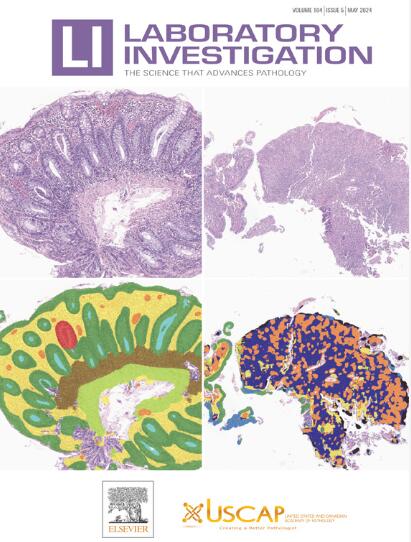综合分析neurod1, ascl1, pou2f3和yap1表达特征揭示了具有潜在治疗意义的独特lcnec亚群。
IF 4.2
2区 医学
Q1 MEDICINE, RESEARCH & EXPERIMENTAL
引用次数: 0
摘要
大细胞神经内分泌癌(LCNEC)可以在基因组上分型为小细胞肺癌(SCLC)样和非SCLC (NSCLC)样。神经d1、ASCL1、POU2F3和YAP1 (NAPY)亚型已被报道用于SCLC。我们用免疫组织化学方法评估了LCNEC中的NAPY以及相关的蛋白表达数据。对133例I-III期LCNEC切除的组织微阵列进行了回顾,并进行了NAPY、pRb、DLL3、cMYC和TTF1的免疫染色。h -评分b>0为阳性(+),bbbb50为显性。使用GeoMX数字空间分析(DSP)进行无监督聚类和空间免疫RNA分析。临床数据来自荷兰癌症登记处。在LCNEC中,ASCL1占26%,NEUROD1占18%。pRb丢失的比例为75%,DLL3+、cMYC+和TTF1+分别为66%、26%和70%。无监督聚类鉴定出5个基于表达的亚组:NEUROD1high-ASCL1high(10%)、ASCL1high(22%)、POU2F3high(5%)、YAP1high(11%)、NAPYlow(51%)。ascl1高亚组与dll3高和高神经内分泌(NE)标志物表达相关。YAP1high对pRb+富集。pou2f3高亚组和yap1高亚组为NE标记低亚组,dll30低亚组。DSP在neurod1high - ascl1high - pou2f3high组中发现了四个参与免疫系统和/或肿瘤发展的上调基因。在对LCNEC中NAPY标志物的综合评估中,我们观察到5个基于表达的亚组:NEUROD1high-ASCL1high、ASCL1high、POU2F3high、YAP1high和NAPYlow。NE亚组(NEUROD1high-ASCL1high和ASCL1high)均有dll3高表达。与SCLC中已知的比例相比,发现的NAPYlow和YAP1high病例较多,而POU2F3high病例较少。与SCLC相比,NAPY在LCNEC中的应用提供了更温和的亚群区分。进一步研究潜在的药物靶点是有必要的,即DLL3和YAP1表达的差异可以指导个性化的治疗策略。本文章由计算机程序翻译,如有差异,请以英文原文为准。
Comprehensive Analysis of Neurogenic Differentiation Factor 1 (NEUROD1), Achaete-Scute Homolog 1 (ASCL1), POU Class 2 Homeobox 3 (POU2F3), and Yes-Associated Protein 1 (YAP1) Expression Signatures Reveals Unique Large-Cell Neuroendocrine Carcinoma (LCNEC) Subgroups With Potential Therapeutic Implications
Large-cell neuroendocrine carcinoma (LCNEC) can be genomically subtyped into small-cell lung cancer (SCLC) and non-SCLC–like. Neurogenic differentiation 1 (NEUROD1), achaete-scute homolog 1 (ASCL1), POU class 2 homeobox 3 (POU2F3), and yes-associated protein 1 (YAP1) (NEUROD1, ASCL1, POU2F3, and YAP1 [NAPY]) subtypes have been reported for SCLC. We immunohistochemically evaluated NAPY in LCNEC alongside relevant protein expression data. Tissue microarrays from 133 stage I-III resected LCNEC were reviewed and immunostained for NAPY, protein retinoblastoma (pRb), delta-like ligand 3 (DLL3), cMYC, and thyroid transcription factor 1. An H-score of >10 was considered positive (+), and >50, dominant. Unsupervised clustering and spatial immune RNA profiling using GeoMx Digital Spatial Profiling (NanoString Technology) were performed. Clinical data were obtained from the Netherlands Cancer Registry. ASCL1 was dominant in 26% and NEUROD1 in 18% of LCNEC. pRb loss was observed in 75%, and DLL3+, cMYC+, and thyroid transcription factor 1+ in 66%, 26%, and 70%, respectively. Unsupervised clustering identified 5 expression-based subgroups: NEUROD1high-ASCL1high (10%), ASCL1high (22%), POU2F3high (5%), YAP1high (11%), and NAPYlow (51%). Both ASCL1high subgroups correlated with DLL3high and high neuroendocrine (NE) marker expression. YAP1high was enriched for pRb+. POU2F3high and YAP1high subgroups were NE marker low and DLL3low. GeoMX Digital Spatial Profiling identified 4 upregulated genes involved in immune system and/or tumor development in the NEUROD1high-ASCL1high-POU2F3high- group. In this comprehensive evaluation of NAPY markers in LCNEC, we observed 5 expression-based subgroups: NEUROD1high-ASCL1high, ASCL1high, POU2F3high, YAP1high, and NAPYlow. The NE subgroups (NEUROD1high-ASCL1high and ASCL1high) were recognized with DLL3high expression. Compared with the proportion known in SCLC, more NAPYlow and YAP1high and fewer POU2F3high cases were identified. Application of NAPY in LCNEC provides a more modest discrimination of subgroups compared with SCLC. Further research on potential drug targets is warranted, ie, differences in DLL3 and YAP1 expression could guide personalized treatment strategies.
求助全文
通过发布文献求助,成功后即可免费获取论文全文。
去求助
来源期刊

Laboratory Investigation
医学-病理学
CiteScore
8.30
自引率
0.00%
发文量
125
审稿时长
2 months
期刊介绍:
Laboratory Investigation is an international journal owned by the United States and Canadian Academy of Pathology. Laboratory Investigation offers prompt publication of high-quality original research in all biomedical disciplines relating to the understanding of human disease and the application of new methods to the diagnosis of disease. Both human and experimental studies are welcome.
 求助内容:
求助内容: 应助结果提醒方式:
应助结果提醒方式:


